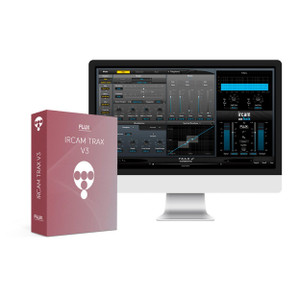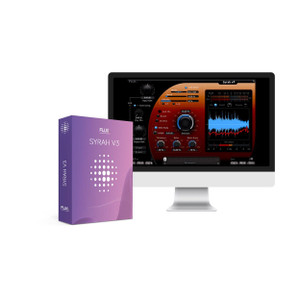Flux Ircam Hear V3 (Download) Binaural Encoding Tool
Digital licenses are usually delivered via email within 15-20 minutes of ordering.
We encourage customers to install trial versions to ensure they work on their system prior to purchasing
Once redeemed it is not always possible to take returns or refund software licences
Key Info
Ircam HEar provides faithful reproduction of a stereo mix or a full surround mix with up to ten channels, supporting Dolby Atmos, with a pair of conventional stereo headphones. It relies on proven technology to model the various phenomena that occur when playing back audio material through a loudspeaker system.
Ircam HEar v3 Faithful binaural reproduction of a stereo mix or a full surround mix with up to ten channels, supporting Dolby Atmos, with a pair of conventional stereo headphones.
Binaural technology Binaural technology encompasses methods for recording, processing, synthesizing and reproducing sound that are specifically designed to preserve tridimensional localization properties.
In order to mimic the impression of a sound originating from a given incidence, it is sufficient to filter a mono signal, which on its own lacks any kind of spatial information, with both left and right HRTF filters. This constitutes the foundation of binaural synthesis.
Please note that the resulting signal is only meant to be listened to with headphones, and isn’t designed for a conventional stereo loudspeaker setup.
Signal Routing and Speaker setup A routing Matrix provides an overview of the mapping between the plugin’s inputs from the DAW track to the virtual speaker internal outputs, and a Speaker Mode specifying which virtual speaker configuration that should be emulated.
Highlights
- Up to ten channels Input/Output with support for Dolby Atmos
- Pro Tools HD 7.1.2 & 7.0.2 Dolby Atmos Bus Support
- Space Presets, presenting a range of spaces with subtly different colorations
- Routing Matrix for mapping between the plugins inputs from the DAW track to the virtual speaker internal outputs
- Speaker Mode specifies the emulated virtual speaker configuration
- Speaker Width to control the width between virtual speakers, expressed in degrees, which allows for narrowing or broadening the stereo image.
- Angle Shift to control the angle between the listener and the center of the virtual speakers
- HEar relies on HRTF filter measurements made using a KEMAR (Knowles Electronics Manikin For Acoustic Research) dummy head and torso simulation.
System Requirements
PC
- Windows – 7 SP1, 8.1 and 10, all in 64 bits only.
- A graphic card fully supporting OpenGL 2.0 is required. USB displays are not supported.
- Windows: If your computer has an ATi or NVidia graphics card, please assure the latest graphic drivers from the ATi or NVidia website are installed.
Mac
- Mac OS X (Intel) – All versions from 10.11 (64bit only)
- A graphic card fully supporting OpenGL 2.0 is required. USB displays are not supported.
- Mac OS X: OpenGL 2.0 required – Mac Pro 1.1 & Mac Pro 2.1 are not supported.
- SKU:
- IRCAM-HEAR-V3
- Model Name:
- Ircam Hear V3 (Download)
- Brand:
- Flux
UK Delivery
FREE Standard Delivery on orders over £99.00.
Orders placed before 4pm will normally be dispatched the same day.
Please refer to our delivery schedule for exceptions.
Delivery Upgrade Options (Over £99)
- Express Next Working Day - £5.99
- Next Working Day Pre 12pm - £8.99
- Saturday / Sunday - £9.99
At Music Matter, our goal is to ensure complete satisfaction with your purchase.
If, for whatever reason, you are dissatisfied with your purchase, you can return it to Music Matter within 30 days of receiving the item, providing it arrives back in new condition.
You have the option of receiving a full refund / exchange within 14 days, or, exchange / credit only within 30 days.
Full Refund Within 14 days
In order to receive a full refund, you must notify us within 14 days of receiving the goods. Once you have notified us you will have 14 days to return the product to us.
Exchange Within 30 days
In order to exchange an item, you must notify us within 30 days of receiving the goods. Once you have notified us you will have days to return the product to us.
Goods received back 14 days after the cooling of period ends may be rejected.
Your returns period starts the day after you receive the item(s)
Click here to view our full Returns Policy.
Secure Online Payment Powered By Sage Pay
We accept the following debit / credit cards:

Paypal
Pay for your item(s) in just a few clicks with PayPal.

Pay Later with PayPal Pay in 3
Split purchases into three interest-free monthly payments at millions of stores online.
Subject to status. UK residents only. Late fees apply. PayPal is a responsible lender. Pay in 3 performance may influence your credit score. T&Cs apply.
Check out securely with PayPal and choose Pay in 3 from your account.
Subject to status. Terms and Conditions apply. UK residents only. PayPal is a responsible lender. Pay in 3 performance may influence your credit score. PayPal Pay in 3 is a trading name of PayPal (Europe) S.à.r.l. et Cie, S.C.A., 22-24 Boulevard Royal, L-2449, Luxembourg.
Click here to learn more about Pay in 3.
PayPal Credit
0% interest for 4 months is available on single transactions of £99.00 or more.
PayPal Credit is like a credit card, without the plastic. It's a credit limit that's attached to your PayPal account which you can use for your online purchases.
Check out securely with PayPal and choose PayPal Credit to apply for credit.
Finance provided by PayPal Credit. Credit subject to Status. Terms and Conditions apply. Music Matter acts as a broker and offers credit from PayPal Credit. PayPal Credit is a trading name of PayPal (Europe) S.à.r.l. et Cie, S.C.A., 22-24 Boulevard Royal L-2449, Luxembourg.
Minimum 12 Months Warranty
All new & used goods supplied by Music Matter are warranted free from defects for 12 months from the date of supply (unless otherwise stated).
Extended Warranty
Many manufacturers offer a free extended warranty upon registration.






